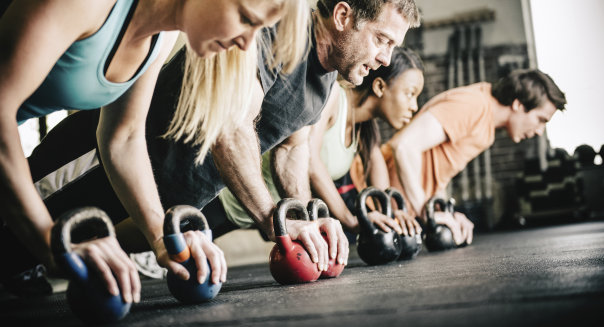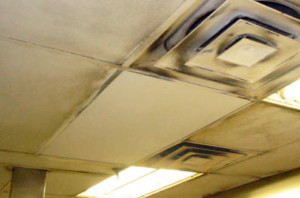
Want yet another reason to spend less time at the gym (unless you’re doing HIIT, of course)?
Here are several. Warning: this is gross.
TLDR: Recent studies point to higher levels of carcinogens in fitness center air, as well as significant amounts of harmful bacteria on surfaces.
Choose a well-run gym, and make sure to get outdoors to move around – and do a brief, Bulletproof style HIIT workout at the gym (or at home).
The Air You Breathe Can Make You Weak
It’s no secret that air pollution makes us weak. (Weak like, you know…dying.)
The CDC, EPA, and lots medical journals point out that exposure to air pollutants in urban areas is linked to higher rates of asthma and abnormal heart rhythms, and increases the risk of death from cardiovascular disease, respiratory diseases, and all causes, period.[[1],[2],[3]]
This is all well and good, until you take note of recent data showing that the indoor air quality in some fitness centers may be just as harmful to health.
Yikes!
So if you want to ride a bike fast while breathing really hard, why not find a nice tree-lined park? Or if it’s winter or dark outside, find a really well-run gym with great air.
Air Quality At Indoor Fitness Centers: It’s Just About What You’d Expect
A study last year in the journal Building and Environment found unacceptably high levels of carbon dioxide, formaldehyde and other volatile organic compounds (VOCs), and particle pollution in multiple indoor fitness centers in European fitness centers comparable to average US facilities. (Although the quality of your own gym may be wonderful…)[4]
Carbon dioxide levels rise when there are more people in the room, when the exercise harder, and when there isn’t enough ventilation. Basically, the more people you cram into a windowless space doing long stretches of high-intensity aerobics, the worse off the quality of air in that space.
The study showed the highest levels of CO2 in an interior room used for indoor cycling. The carbon dioxide levels measured here are not toxic, but they’re not innocuous, either. An excess of carbon dioxide can make it harder to breath, and can make you feel sluggish or dizzy – not optimal sensations for a healthy workout.[5] In fact, all building owners (sometimes your gym does not own the building it’s in) save money by recycling used air instead of heating or cooling fresh air from outside.
Oxygen is so important to recovery that I installed an hyperbaric oxygen chamber in the Bulletproof Biohacking Labs, and I monitor CO2 levels there!
Is your gym moldy?
Over the past 18 months, I’ve been traveling the country to interview top experts in environmental mold, one of the largest causes of indoor pollution. It’s part of a large-scale documentary about hidden mold called Moldy as part of my goal to film documentaries every 2 years about hidden sources of environmental “kryptonite” that are slowing down at least 100 million people.
Indoor mold is far more important than asbestos or lead, and it’s common in gyms because gyms are full of moist air. Think about it – the swimming pool area, the sauna, the showers that are in use all day long, the windows steamed up with sweaty air – all of them provide enough humidity for indoor mold to take hold and begin producing mold toxins. Inhaled mold toxins are far more harmful than the ones you eat, which are not good for you either!
There is not widespread air quality testing in gymnasiums or schools, but there is one study (from Malaysia, which is humid) showing that fungal DNA contamination was common in schools there, and it was associated with respiratory symptoms.[6]
From a personal perspective, having grown up in a basement with water damage, and experiencing the whole host of mycotoxin symptoms (you know, obesity, autoimmunity, CFS, allergies, asthma, brain fog, nose bleeds, etc.), my immune system is still sensitized to these toxins. I feel them when I walk into a moldy building…and when I drink a cup of moldy coffee.
And more than a few gyms (especially indoor pools) have unacknowledged mold problems, including the local community pool where I live. If your gym smells like sweat-socks, it’s a sign of a bigger moisture (and probably fungal) problem!
Indoor Particulate Matter Is Harassing Your Lungs
Another concern is the level of “particulate matter” in indoor spaces.[7] Particulate matter is a mixture of solid and liquid droplets (including nitrates, sulfates, organic chemicals, metals, and soil or dust).
Particles of concern are those that are small enough to pass through nasal cavities and enter the lungs where they cause health problems. Over a quarter of the gyms in the European study exceeded the indoor limit for particles of this size, called “PM10”.
Particles and chemicals can come from rubber mats, metal plates banging together, and dead pieces of skin from other people working out. Good quality air filters and regular cleaning can help a lot…unless the cleaners are made of toxic chemicals, which enter the air and get recirculated. Not bulletproof!
Unsafe Levels of Volatile Organic Compounds Are Especially High At Newer Facilities
In addition, over eighty percent of the gyms studied exceeded the acceptable level of unsafe volatile organic compounds (VOCs). These compounds include formaldehyde, fire retardants, acetone, and other substances that arise from carpeting, furniture, cleaners, paint, among others.[8]
Levels of VOCs are higher in gyms with newer equipment, and in spaces that have been recently cleaned (because of the chemicals used).[9] Exposure to VOCs in high levels can cause skin irritation, neurotoxic, and hepatotoxic (toxicity of the liver) effects, and certain of them are carcinogenic.[10]
VOCs are a problem in most modern buildings, and they can make you tired, unfocused, and cranky. I remember when my company years ago remodeled our headquarters (that building eventually became Yahoo’s headquarters!) When we did it, the air smelled like furniture from China (formaldehyde) and for some strange reason, everyone had “allergies” for 3 months.
When I asked the building facilities manager (Tex was his name) what percentage of air was recycled, he said it was nearly half to save electricity. I asked him to increase the amount of fresh air, and when he did, suddenly the dry itchy eyes and “allergy” complaints got much better. It wasn’t allergies – it was our bodies telling us that the VOCs were causing harm.
Dirt In the Air in Your School, Literally
Less scary but still concerning is the fact that school gymnasiums are widely found to have high levels of re-suspended “coarse particular matter” such as dust, soil, and bacteria that may trigger immune and/or allergic responses in susceptible individuals.[11]
Again, frequency of use (i.e., how many kids are running around in the space and how often they do it) determines the level of undesirable junk in the air.
And how many schools have the budget to clean their gyms adequately? Support fully funded schools already!
Gym quality is almost as important as food quality
So what’s an active person to do?
Remember: there’s a big difference between movement and exercise! Read Bulletproof Body blog post or listen to Bulletproof Radio #164 with Dr. Doug McGuff to learn more about Bulletproof exercise.
- Understand that indoor fitness centers are not always the best place to get in your exercise – quality matters.
- Don’t do cardio in the gym unless you like breathing other people’s exhaust air. (Cardio is not very effective, anyway, except for sprints!)
- Ask your gym to stop using toxic cleaning products, especially those with synthetic fragrances, which are proven to be endocrine disruptors. Avoid using those toxic cleaning products at home as well.
Brief intense exercise in clean air spaces is the best way to go.
Instead of going into a dark, poorly-ventilated room intending to “burn off calories” by running on a treadmill, take a more lighthearted and natural approach to physical activity.
Meanwhile, get outdoors for your movement: take a hike, walk around your neighborhood, or do some yoga in a well ventilated studio. Also spend time in a green space with oxygen-rich air (trees emit the stuff, you know), and do something that makes you breathe it in deeply for a little while.
References
[expand title=”Click to read the complete list of references.” swaptitle=”Click to hide references.”]
[1]http://www.epa.gov/airnow/2014conference/Plenary/Monday/Boehmer_NAQC_2014_final2.pdf
[2] http://www.ncbi.nlm.nih.gov/pubmed/25712593
[3] http://www.nejm.org/doi/full/10.1056/NEJM200012143432401#t=abstract
[4] http://www.sciencedirect.com/science/article/pii/S0360132314002856
[5] http://toxtown.nlm.nih.gov/text_version/chemicals.php?id=31
[6] http://www.ncbi.nlm.nih.gov/pubmed/21457336
[8] http://www.epa.gov/iaq/voc2.html
[9] http://www.sciencedirect.com/science/article/pii/S0360132314002856?np=y
[10] http://ibe.sagepub.com/content/12/6/427.full.pdf+html
[11] http://www.sciencedirect.com/science/article/pii/S0013935111000934
[/expand]













